Product Requirements:
An uncovered light socket or light fixture
I am not going to kid you for a moment – when I heard that there was a light bulb claiming it could eliminate odors, I thought it was the biggest bunch of flimflammery ever.
But you know me, I am willing to give anything a try…
Technical Consumer Products, Inc. (TCP), makers of compact florescent lighting, have created a bulb that they claim will eliminate strong offensive smells such as fish in the kitchen, musty laundry room odors or even pet smells – kitty box, anyone? Do these bulbs live up to the hype? We’ll get to that in just a moment. But first I would like to tell you a little bit more about the fluorescent bulbs themselves…
Fresh² Florescent Bulbs are similar in style to other compact fluorescent bulbs in that they resemble a long white tube that has been bent into a spiral and they can be used in a regular light socket instead of a traditional long fluorescent light fixture.
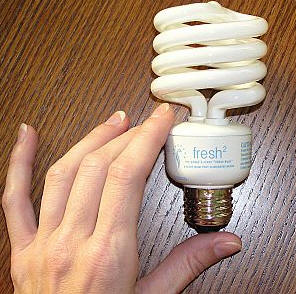
For those of you that are unfamiliar with fluorescent lighting, just think of the long tube style light fixtures that line just about every commercial building in the world’s ceilings. There is a reason that these bulbs are in place. Fluorescents are energy efficient, using from one quarter to one-third of the energy needed to burn a traditional incandescent; they also don’t put out the heat of the incandescent bulb. Perhaps one of the best properties of fluorescent bulbs is that they last significantly longer than traditional incandescents. How much longer? A typical incandescent bulb will give 750 to 1,000 hours of life. Compare that to a fluorescent light, which will last for 10,000 hours or more.
Be sure to check out the chart at the bottom of this page, which is on the Consumer Energy Center’s site. It is especially relevant to this review because it compares the economics of using a 23 watt compact fluorescent versus a 100 watt incandescent light bulb. Both bulbs are emitting the same amount of light, but the fluorescent is doing it much more effectively. The Fresh² is just such a 23 watt bulb.
So, getting back on track, we should all be able to agree that a compact fluorescent bulb is a better choice for anyone that wants a cooler burning, longer-lasting, more economical choice of lighting. At an average price of $11 a bulb, the savings become evident after the bulbs have been in place for several years, lasting several times longer than their incandescent cousins. What sets the Fresh² bulbs apart from similar compact fluorescent bulbs is the fact that they are coated with Titanium Dioxide. When the light is turned on, it activates the coating which releases “extremely strong” odor fighting oxidizers. This oxidation process is supposed to “break down odors completely.”
Googleing TiO(2) shows that it has a variety of uses – everything from being the white pigment in paint and paper to its use an ingredient used for absorbing odor in foot creams. I even found one study where TiO(2) was being suggested as a possible way to cut down odors in swine farming operations. There is obviously a scientific background for using the compound as odor control. The question now is just whether or not a fluorescent
bulb would be a proper application for the science. With this in mind, I looked forward to putting the Fresh² bulbs through their paces.
Since the Fresh² bulbs are shipped directly from the manufacturer to your door, they are packaged a bit better than the average bulb you would pick up at the grocery.
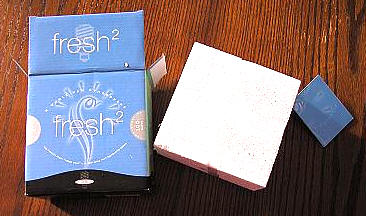
Inside a cardboard box is a molded Styrofoam shell that holds two Fresh² bulbs. In case you were wondering, the blue booklet offers a free t-shirt to users that write in about their experience with the bulb.
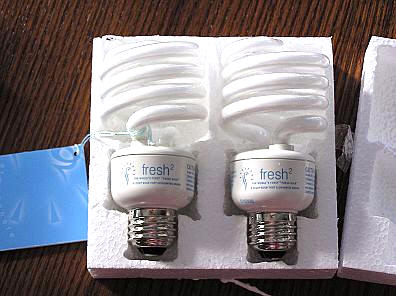
As you can see, the base of each bulb is sized to fit a typical light bulb socket. Almost every light fixture in my home is recessed and usually holds a 75 to watt indoor flood lamp. We will not even begin to discuss how hot a room can become when I have these lights on for any amount of time. Since these bulbs are most effective when they are in an open socket that allows unfettered air-flow, the fixtures in my house are
actually quite perfect for testing.
The size of the room does have an effect on how well the bulbs work, so if you have a larger space, you might want to go ahead and replace several bulbs with Fresh²s. Since I only had two to test, it worked out best that I try them in two smaller rooms: the laundry room and bathroom.
My laundry room has a typical old fashioned ceramic socket which hangs unenclosed from the top of the 10′ ceiling. The room is not huge, it is about the size of a large closet. It not only holds the washer and dryer and water heater, it is also home for a hamper which is in a constant flux of varying degrees of fullness from of dirty clothes. This room is also the place where I store the dogs’ food. I would not go so far as to say that the room smells bad, but it does have a slight odor most of the time.
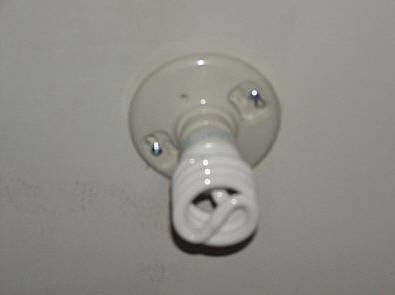
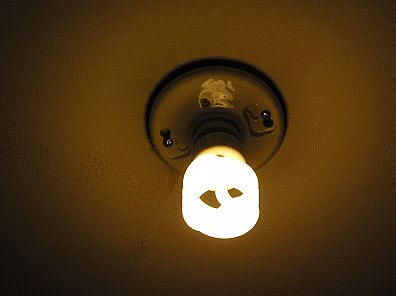
Next is the master bath, which has three recessed flood lights: two above the vanity and one above the commode. The light above the commode is also near the built-in hamper, so this seemed like a good location for the Fresh² bulb. The built-in hamper can sometimes acquire a bit of a musty smell as it holds not only clothing but also damp towels.
Removing the flood lamp revealed a larger space than called for with the Fresh², but I figured that since the bulb needs an uncovered socket to operate, perhaps the extra bit of air-flow area on the sides wouldn’t hurt.
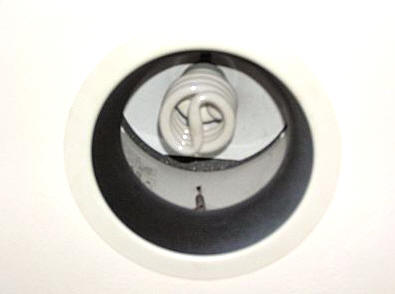
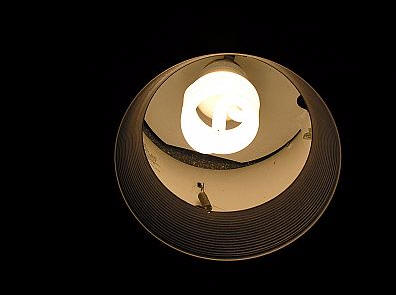
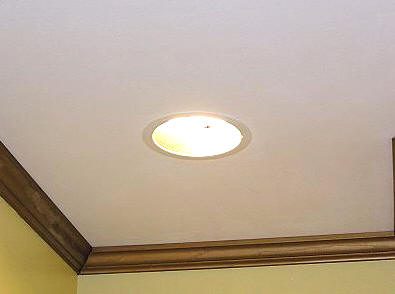
With the bulbs installed in both locations, and with the doors shut to cut down on the size of the area that the bulbs would have to affect, I left the lights on and walked away for ten minutes. When I came back, I thought I could tell a noticeable change. After an hour, I knew there was a major difference. Steve even commented on it, and he had begun as an even bigger skeptic than me about whether or not they would make a difference – much less work as advertised.
Now for those of you that usually buy scented candles, room sprays and solid deodorizers to cover odors, I should point out right now that I did not walk in and smell flowers. Instead, I smelled nothing. Just clean, fresh air in both rooms. I was also pleased that the light cast by the bulbs was bright and white. There was no flickering or humming like I have associated with the old fluorescent tubes of the past.
Fresh² bulbs would be perfect in any room that has a musty odor or that needs deodorizing without introducing harsh chemicals. Immediately coming to mind are uses such as in a baby’s nursery, a room where cigars are allowed, and definitely any room that houses a cat’s litter-box. I think the perfect way to use these bulbs would be to leave them on all the time if you have an area that is particularly prone to odors. Because of their long life and energy efficiency, I doubt that they would cost any more to run full time than a part time incandescent bulb would.
These bulbs have made a believer out of me. I challenge those of you that have a musty room, or who allow pets in the house, to order a set of these bulbs and give them a try. All I ask is that when you try them you do as I did and put them in an uncovered socket or in a lamp with an open shade – not in an enclosed light. If you are going to try them in a larger room, then use a couple of them – don’t expect one to deodorize your entire living room and leave them turned on! Get over the weirdness that comes with thinking about a light bulb cleaning the air, and just give it a try. You have absolutely nothing to lose on so many levels. Not only will you be getting more energy efficient bulbs to take the place of your existing incandescent ones, if you don’t feel that the Fresh² bulbs are performing as I say they will, then you can send them back for a refund within the first 90 days – including $5 for the return shipping!
Fresh ² Bulbs can be purchased here.
Price: $19.99 for a two-pack
Comes with a 90-day money back guarantee (+5 for shipping) and a one-year
warrantee against defects
Pros:
Energy efficient compact florescent bulbs fit in traditional incandescent bulb
socket
Bulbs actually remove odors while turned on
No heavy perfumes or other additives in air – it just smells clean
Cons:
It just seems weird to say your light bulb is cleaning the air – don’t
let it get to you, though
Product Information
| Price: | 19.99 |
| Manufacturer: | Techinical Consumer Products, Inc. |
| Pros: |
|
| Cons: |
|

Gadgeteer Comment Policy - Please read before commenting
Post your comments here on the Fresh² Odor Eliminating Light Bulbs.
http://www.the-gadgeteer.com/fresh2-odor-eliminating-light-bulb-review.html
Just click the POST REPLY button on this page.
It’s highly likely (especially reading the FAQ at the Fresh2 website) that what is occurring when those bulbs are on is that they are generating O3
(ozone) from the coating on the bulbs.
Ozone is a very strong oxidizer, and is very effective at controlling odors… The only problem is that it’s also pretty darn bad for you. It can trigger severe reactions in people with asthma, and is a major component of smog in metropolitan areas. Ozone is fine in the upper atmosphere where it blocks UV radiation, but you definitely don’t want to be breathing it all the time.
Here are some pertinent links:
http://www.cal-iaq.org/o3_fact.htm
http://en.wikipedia.org/wiki/Ozone
http://www.cdc.gov/niosh/pel88/10028-15.html
http://www.idph.state.il.us/envhealth/factsheets/ozone.htm
I don’t know what levels of ozone are being generated, but if it’s capable of neutralizing odors, I suggest it’s probably in excess of the EPA and OSHA standards on human exposure which are enforced in industrial and manufacturing settings.
Unfortunately, a lot of people are marketing items that specifically generate potentially dangerous concentrations of ozone under the guise of “air purifiers.” The informed consumer is a safer, wiser consumer.
Just thought I’d give you a heads up. Be safe!
Neil
This product produces no ozone.
While you are quite right that ozone is a strong oxidizer that is used to control odors, and that it is dangerous if concentrated enough to have any effect on odors at all, that is not at all what TiO² does.
TiO² is a Photocatalyst. It reacts with UV light to accelerate the break down of organic material. Since it is also a white powder that can be applied to a glass surface as a light diffuser it makes a great combo for something like this. 😀 It defuses the light, controls odors and filters out the UV light from the bulb all in one.
Instead of putting extra oxygen into the air like O³ (ozone) does, this pulls carbon our off organic material and combines it with oxygen to form CO². What is left of the organic molecule that is causing the bad smell breaks apart and reforms into smaller molecules that we can’t smell very well, if we can smell them at all.
The reason the Fresh² needs air circulation to work isn’t so it can spread ozone around (if it was then they would have named it Fresh³ :p ) but because it needs the organic particles floating in the air to come in contact with the TiO² coating on the light bulb’s surface.
For more info on TiO² you can google it yourself like Judie did or just go to this link for the basic mechanics of how it works.
For anyone else out there who is still curious about ozone, I find the EPA Indoor Air Quality website to be very informative.
As noted in the previous comment, TiO2 is a catalyst and can be used to breakdown organic compounds in the presence of light. Currently in Japan there are self cleaning windows on sale with thin coatings containing TiO2 as well as self cleaning paints. See the the link below for some applications.
http://www.titaniumart.com/photocatalysis-ti02.html
Self cleaning car paints have been mentioned as a possible application.
Thanks for the Tip 🙂
I found this link to be highly informative:
http://ehp.niehs.nih.gov/docs/2001/109-4/innovations.html
I didn’t mean to be an alarmist. The only research I did after reading the review was visit the manufacturer’s website. They’re a little vague about what is going on, but their faq suggests that the bulbs produce “powerful oxidizers”, which made me think about ozone…
My mistake for leaping to the wrong conclusion. The link provides some pretty interesting reading about TiO2 in general.
I’m suddenly thinking a litterbox with a light and fan mounted in the top of it might sell well… 😀
That is a great link. The information it has is much more interesting than the one I posted. It is good to see all of the products that could soon be incorporating TiO².
As to the light in the kitty litter box, that would certainly keep scared kittens from being too afraid of the dark to go late at night.
But seriously, that is a great idea that could be taken a step further, in addition to the light, the container itself could be coated with the material. The lining on the inside would probably never get enough UV exposure to do much of anything, but the coating on the outside would kill off all that bacteria that is so dangerous for expecting mothers and their unborn children. It still wouldn’t be safe for them to change the litter box themselves, but it would seriously reduce the chance of any dangerous bacteria infecting them by indirect means.
Are there any specs on how long the coating itself lasts? It seems like the coating might run out before the bulb does.
TiO2 is an inorganic catalyst and is not consumed in the reaction. However, depending on how the coating is applied, the matrix containing the catalyst could deteoriate for various reasons. Since TiO2 catalysts are being considered for self cleaning windows, the manufacturers are developing those products based on the assumption of a long product life.
I wholeheartedly agree with Judie’s review. I ordered a pair of the bulbs after seeing the rec on Cool Tools, and I’m very happy with the way they’re handling Eau de Litterbox and Mystery Corgi Aroma.
Mystery Corgi Aroma? 😉 Hmmmm…. at my house, we call that Corgi frito feet 😉
> Corgi frito feet
Oh, lord. That’s a perfect name for it, but now I’ll never eat Fritos again without thinking “Eww.”
It’s a good thing I have magic deodorizing lightbulbs.
I was looking online and found your link as it mentioned a use for TiO2. I found a new mosquito trap called the Black Hole make in Korea which uses TiO2 to create CO2 to attract mosquitos to a trap but I am skeptical as to how much CO2 it produces if it is outside and at the edge of your house where there is fresh clean air rather than musty odors. Here is the link and I was wondering what other people thought. http://www.1mosquito-control.com/Mosquitoes-trap-black-hole.htm
🙂
Would these bulbs be safe to use around pets, especially birds? Thanks.
In re: Ozone; you’re both wrong! There is a lot of literature about this, mostly since 1994 when the Japanese firm that makes silk plants with titania on them (TiO2 made them kind of glisten, and it didn’t dust up like other silk plants…what was with that, they properly wondered) sponsored some research; and when independent researchers found the mechanism for atmospheric cleansing because ultrafast molecular analysis was coming to be practical (whether it was called LIDAR or not.)
A big takeaway is that it’s the same mechanism as atmospheric cleansing (i.e. how fresh air gets that way, which it does at night with very spare UV, as well as in the day.)
At any rate, some of the radical moieties titania makes of water and other molecules and UV light (so, that and the mercury in the CFL are your base hazards, really) are indeed ozone. Additionally, it’s basically oxidizing your stink molecules (think of hydrolizing fatty acids right up near the backbone; that’s your trouble VOC grease your guts couldn’t turn into useful exchangeable parts) into CO2; the combustion makes some heat. However, because the incandescent bulb brought us precautions in bulb use, you can use these things with no -additional- worry over the bulbs we hope to deprecate.
That said, if you were a little sloppy with filament bulbs and put them in front of your Vermeer or closely over your wardrobe, you will -not- be pleased with the bleaching effect of these CFLs!
Read magazines or podcasts like _Science_ or _Nature_ offer and you get spades of this stuff, plus some distracting stuff that takes a while to make practical use. People are still trying to get this to work with 80-190% (go to…..) humidity or in the middle of flow in sewage, industrial byproducts they want general hydrolization on, etc.
Please link if you know how to find architectural fascia or tile products with TiO2 microstructures on them; they’re in common use, but I haven’t gotten them to stir up in searches…
An ideal bulb might make crack bad air into good plus vacuumable mulch, taking notes about the sources; but this is good stuff. The only changeup is that you need the bulbs exposed, so fixtures have to be prettified s.t. the protective dome is no longer necessary. I am hope a mix of tiling the heat shield (e.g. on a ceiling badge) and mobiles can help.
There is this adjunct product which is titania in suspension; thing is, nobody gets direct sun on mini-blinds that are behind glass? If they do, I guess the roof’s open. But you don’t want to put UV LEDs on treated blinds when people could be around to get ‘sun damage’; just the opposite of PIR lighting’s usual case. You also may or may not like the way it eats (or does not eat) the paint off your blinds and ages nearby things; if they’re ceramic or glass, they’ll probably age fine. Those silk plants with TiO2 (link also appreciated) age great, but they’re coated.
Can’t convince my wife there are helping in the family room, home for my 2 labs…..Help
Your links don’t work. I tried to order some bulbs by clicking order “here” and got no response.
Here’s an alternative bulb with the same odor fighting features: http://amzn.to/2aNPsQG
Can I use in lamps with shades?